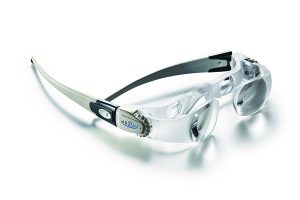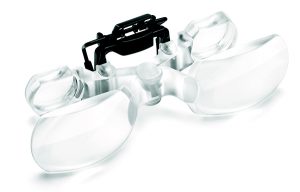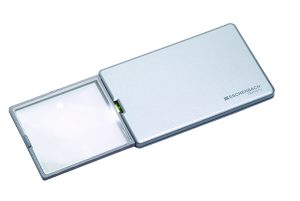Low Visual Aid Clinics
So, I had my first appointment at the Low Visual Aid (LVA) Clinic. Wow, I came away feeling quite upbeat and positive.
I didn’t really know what to expect form this appointment. The sight loss is a whole new journey for me. The appointment was a long time coming – or at least it seemed a long time., I was registered as Partially Sighted (Visually impaired) on 11th June 2018. My low visual aid appointment was on Monday 30th July.
I arrived at the clinic, full of apprehension. I wasn’t at all familiar with he building, and it took me a while to find the entrance, as I couldn’t clearly make out the signage. When I gave my details, I was told that it was up there, take a left , along the corridor, second door on the right, waiting area 4! Occasionally holding onto pieces of furniture and walls, as I gingerly tried to find m,y way, I eventually got to where I needed to be. I sat in the waiting area, and got a little upset, looking around me, not being able to read the posters on the walls, the leaflets in the racks or the hospital signage. So, I sat there, hoping when someone called my name they would appear in front of me, so I could see them.
The lady (Debbie) called my name, and came over to me. She actually sat beside me to talk to me, facing me and speaking to me in a. reassuring way. She explained that she had a trainee optician with her in clinic and would it be ok for him to be present at my appointment? of course, I was happy for this to happen.
Debbie stood up, and walked beside me to the clinic room. I actually started to relax a little and her continually reassuring manner was very welcome, and made feel at ease. Having her walk beside me was a great relief, as I was used to people just marching ahead and me trying to quickly follow them.
I sat down at the desk and was introduced ti the trainee optician. Debbie asked me some questions and asked me to talk to her about the things I was struggling with and what I did for a living etc. As I did so, m she made notes on her computer, so that she could come back to the points later in the appointment, so as to not miss anything we chatted about.
Debbie then explained that someone with sight loss slowly builds up a collection of aids in an attempt to retain as much independence as possible and to be able to operate in as safe a way as possible. She explained that not every visual aid will be suitable for every task, and thats why people had to build up a collection.
The first issue was reading. I have always been an avid reader, and the fact that this was now such. struggle, had a real impact on me. Not being able to read impacted my ability to work ( I need to be able to read my clients consultation forms and treatment notes, read the labels on products I use during treatments, see the various readings on the equipment I use ). On a personal level, I also need to be able to read my post/correspondence, research articles, instruction manuals, food and medicine labels and of course, books – I LOVE books. I have tried audio books, but I just cannot get into them at all.
Low Visual Aid Devices Recommended too me
-
Magnifying low visual Aid 1
Amazingly, Debbie reached into her cupboard and brought out a collection of different magnifying aids to loom at and try. We ascertained the magnification level I needed, and then actually played with the different magnifiers to see which I found the easiest to use. Discretion is a big thing for me, and I cannot (at the moment) face people knowing about my sight loss, so, discreet magnifiers that I could hide/ disguise with my hand was important. I tried magnifiers that sat directly onto the reading material, as well as those which you held above. Magnifiers with LED lighting and those without. We eventually came up between us with one that was LED illuminated and small enough for me to use behind a clipboard when looking at my client consultation forms so that my clients wouldn’t necessarily know I was doing this. It also worked a treat for reading books at home, and letters etc.
Here is the one that has been ordered for me, and that we felt best achieved what we wanted/needed it to do.
-
Magnifying low visual aid 2 and 3
Next on the agenda was that as a therapist, I often do close, detailed work (Waxing, Hair Removal for example). I have always provided an excellent hair removal service, but, at the moment, ai am missing some hairs and therefore my standard of work is not on par. I mentioned that I had seen people such as dentists that have magnification lenses fitted to their glasses, and wondered if there was anything like this, and If it would be appropriate for me. Once again, as if by Magic, Debbie produced a pair of magnification spectacles and also a clip on device to attach to my existing varifocal spectacles. The first pair I tried on looked a little strange, but, when I put them on, the clarity to which I could see things from a distance was amazing. They had two little “wheels” that you turned to get the magnification just right. And this would be fine for the working distance between me, and my client. I also later discovered that these are brilliant for watching TV, and I assume would be great at the cinema etc too!
The clip on device, I found much more acceptable in that I would not fee as uncomfortable wearing, when facing a client as the previous magnification spectacles I just tried. I put them onto my own glasses, and immediately felt comfortable with them. I cannot tell you how this lifted my spirits, as work is my biggest worry at the moment with my sight loss.
Debbie said to have both aids… the magnification spectacles ( for things like watching TV) and the clip on device for my close up client work).
Here are the magnification spectacles: Here are the Clip on head mounted glasses


Here is a link showing the sprctacle details
- Magnifying low visual aid 4
We discussed problems with me reading menus in restaurants and food labels etc when out shopping, so Debbie showed me a portable magnifier that may help with that, and which isn’t too obvious. I liked this. It is very light, has LED illumination, and just looks initially like a clim metal case. You simply slide out the magnifier and hey presto! So, this also has been ordered for me to try in real life situations.

We discussed that when the magnifiers arrive, then I should use and play with them, and test them out, and that we would then meet again in a months time and see what I think. We can then discuss other aids that I may want to add to my collection to maintain my independence. Debbie said there were devices that with a little practice would make things like recognising bus numbers, train station display boards etc easier to read.
In conclusion,
I was absolutely delighted with the outcome of my Low Visual Aid appointment, and came away feeling much more positive about things, and felt re-assured that there is help out there. So, if you are in the same boat as me, early on in your sight loss journey, or indeed further along. If there is a Low Visual Aid Clinic in your area, take the opportunity to get a referral and see what they can do to help you. All of the magnifying aids discussed above were made available to me Free of charge.
Once I have tried these out, I will post again to let you know how I got on with them. It would be great to hear your views on the subject of Visual aids.